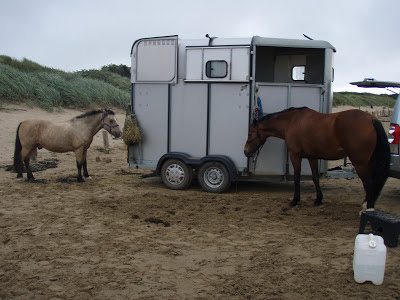
 |
| Julie at the start of the walk |
 |
| Andrea at the start of the walk, sporting 'Gunner Sugden' shorts! |
 |
| Boats moored in the marina by the River Brue |


 |
| Under the curve of the concrete sea wall looking north to the town of Burnham-on-Sea. |

 |
| Small but perfectly formed |
From the park we walked along the banks of the River Brue, to the point where it joins the River Parret, which in turn empties into Bridgewater Bay.
Onwards to the beach at Burnham-on-Sea, with the first glimpse of the pier in the North. This pier is officially the shortest pier in Great Britain!
Looking North to the town of Burnham-on-Sea, with the concrete sea wall, completed in 1988, on the left.
The white roof of the shortest pier in Great Britain coming into view.
The pier in all it's glory!
A ship wreck revealed by the low tide at Gore Sands.
At Berrow Sands we came across a group of model aircraft enthusiasts, who came annually from all parts of the country to fly their 'planes on the flats.
The dunes have been subject to conservation work, which has included the planting of Sea Buckthorn and Marram grass to further prevent the erosion of the dunes.
We passed these beautiful horses taking a break after a gallop up the sands!
At this point in the proceedings a little foolishness. Please meet the third member of our walking party. You may recognise him as Piglet! Piglet was rescued from a plight worse than death on Severn Beach. Since then he has accompanied us on every walk, from his special viewing compartment in Andrea's rucksack!
More horses taking a break as we walk through Brean.
Piglet getting ready to climb the steps to Brean Down (well he only has little legs)!!
Climbing the steps to Brean Down.
Looking South from Brean Down and appreciating the journey we have completed today!
Looking to the headland of Brean Down and Brean Down Fort. The earliest recorded settlement at this site is from the Bronze Age. The current buildings date from the 1860's and was constructed to protect the ports of the Bristol Channel. During World War 2 it was rearmed and used for experimental weapons testing. It has been owned by the National Trust since 2002 and has been renovated, the project costing £431,000.
 |
| Some of the magnificent buildings with bovine friends. |
 |
| The History of the Fort |
 |
| Some of the internal spaces |
The site was used for the filming of the second episode of the BBC television series Warriors.
 Piglet enjoying a break at Brean Down Fort.
Piglet enjoying a break at Brean Down Fort. Walking along the banks of the River Axe, with yachts moored to its banks.
Julie at the end of our walk at The Diamond Farm Touring Park, near Burnham on Sea. We had planned to finish our walk at Uphill, near Weston-Super-Mare. However the heavily fortified sluice gates of the River Axe, put paid to our plans.







































-006.JPG)
-004.JPG)
-005.JPG)


